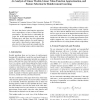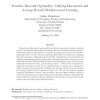2108 search results - page 111 / 422 » Tracking in Reinforcement Learning |
ICML
2008
IEEE
14 years 10 months ago
2008
IEEE
We show that linear value-function approximation is equivalent to a form of linear model approximation. We then derive a relationship between the model-approximation error and the...
ICML
1996
IEEE
14 years 10 months ago
1996
IEEE
Research in reinforcementlearning (RL)has thus far concentrated on two optimality criteria: the discounted framework, which has been very well-studied, and the averagereward frame...
ICES
2003
Springer
14 years 3 months ago
2003
Springer
Abstract. In [8] Yamauchi and Beer explored the abilities of continuous time recurrent neural networks (CTRNNs) to display reinforcementlearning like abilities. The investigated ta...
AAAI
2008
14 years 10 days ago
2008
Potential-based shaping was designed as a way of introducing background knowledge into model-free reinforcement-learning algorithms. By identifying states that are likely to have ...
NIPS
2007
13 years 11 months ago
2007
We provide a provably efficient algorithm for learning Markov Decision Processes (MDPs) with continuous state and action spaces in the online setting. Specifically, we take a mo...


